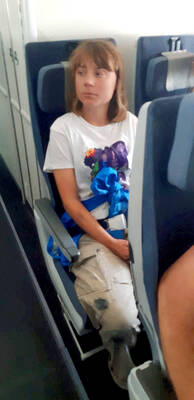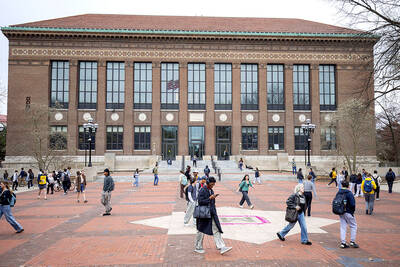It has been three decades in the making: The largest and most powerful telescope ever to be launched into space is finally ready to take up its orbit and beam back new clues to the origins of the universe and Earth-like planets beyond the solar system.
NASA’s James Webb Space Telescope, named for a former director of the US space agency, follows in the footsteps of the legendary Hubble — but intends to show humans what the universe looked like even closer to its birth nearly 14 billion years ago.
Cosmologist and astrophysicist John Mather, who cofounded the Webb project, on Twitter wrote that the telescope “can see the heat signature of a bumblebee at the distance of the MOON.”

Photo: EPA-EFE / NASA / Desiree Stover
All that power is needed to detect the weak glow emitted billions of years ago by the first galaxies to exist and the first stars being formed.
Hubble is capable of observing events that happened in space about 500 million years after the Big Bang, and Webb can go back even further to about 200 million years after that event.
“This telescope is designed to answer the biggest questions in astronomy today,” NASA astrophysicist Amber Straughn said in a 2017 TED talk.
“With Webb we hope to see these infant galaxies, and learn how galaxies grow over time,” she said.
It would also give new information about nearly 5,000 exoplanets. The ultimate goal is to find out whether Earth is unique or whether there are similar planets that could give rise to life.
“There’s a lot of excitement — we’ve been waiting for this moment for a long time,” European Space Agency (ESA) project scientist Pierre Ferruit said.
The ESA and the Canadian Space Agency collaborated on Webb, and Ferruit, like thousands of his colleagues, has been working on it for most of his career. Researchers are already competing for access, he said.
“Observation time is in very high demand. The ESA has received over a thousand applications for just the first year of operation,” he said.
“Even after 20 years, the questions Webb was made to answer are still just as pressing,” he added.
The telescope is unequaled in size and complexity. Its mirror measures 6.5m in diameter — three times the size of the one on the Hubble telescope — and is made of 18 hexagonal sections.
It is so large that it had to be folded to fit into the Ariane 5 rocket that is to carry it to its orbit on Dec. 22.
Once the telescope is in place, the challenge would be to fully deploy the mirror and a tennis-court-sized sun shield — a process that would take two weeks.
Its orbit around the sun would be 1.5 million kilometers from Earth, much farther away than Hubble, which has been 600km above Earth since 1990.
The location of Webb’s orbit is called the Lagrange 2 point and was chosen in part because it would keep the Earth, the sun and the moon all on the same side of its sun shield.
“This will put it in darkness and in extreme cold,” conditions which would allow the telescope’s infrared sensors to “see” without interference — a kind of observation of which the Hubble was incapable, Ferruit said.
The NASA project, launched in 1989, was originally expected to deploy in the early 2000s, but multiple problems forced delays and a tripling of the telescope’s original budget with a final price tag of nearly US$10 billion.
Webb was built in the US and transported to its launch site in Kourou in French Guyana earlier this year.
“All that’s left is to fill up the gas tanks,” Ferruit said.

Swedish campaigner Greta Thunberg was deported from Israel yesterday, the Israeli Ministry of Foreign Affairs said, the day after the Israeli navy prevented her and a group of fellow pro-Palestinian activists from sailing to Gaza. Thunberg, 22, was put on a flight to France, the ministry said, adding that she would travel on to Sweden from there. Three other people who had been aboard the charity vessel also agreed to immediate repatriation. Eight other crew members are contesting their deportation order, Israeli rights group Adalah, which advised them, said in a statement. They are being held at a detention center ahead of a

A Chinese scientist was arrested while arriving in the US at Detroit airport, the second case in days involving the alleged smuggling of biological material, authorities said on Monday. The scientist is accused of shipping biological material months ago to staff at a laboratory at the University of Michigan. The FBI, in a court filing, described it as material related to certain worms and requires a government permit. “The guidelines for importing biological materials into the US for research purposes are stringent, but clear, and actions like this undermine the legitimate work of other visiting scholars,” said John Nowak, who leads field

Former Nicaraguan president Violeta Chamorro, who brought peace to Nicaragua after years of war and was the first woman elected president in the Americas, died on Saturday at the age of 95, her family said. Chamorro, who ruled the poor Central American country from 1990 to 1997, “died in peace, surrounded by the affection and love of her children,” said a statement issued by her four children. As president, Chamorro ended a civil war that had raged for much of the 1980s as US-backed rebels known as the “Contras” fought the leftist Sandinista government. That conflict made Nicaragua one of

NUCLEAR WARNING: Elites are carelessly fomenting fear and tensions between nuclear powers, perhaps because they have access to shelters, Tulsi Gabbard said After a trip to Hiroshima, US Director of National Intelligence Tulsi Gabbard on Tuesday warned that “warmongers” were pushing the world to the brink of nuclear war. Gabbard did not specify her concerns. Gabbard posted on social media a video of grisly footage from the world’s first nuclear attack and of her staring reflectively at the Hiroshima Peace Memorial. On Aug. 6, 1945, the US obliterated Hiroshima, killing 140,000 people in the explosion and by the end of the year from the uranium bomb’s effects. Three days later, a US plane dropped a plutonium bomb on Nagasaki, leaving abut 74,000 people dead by the